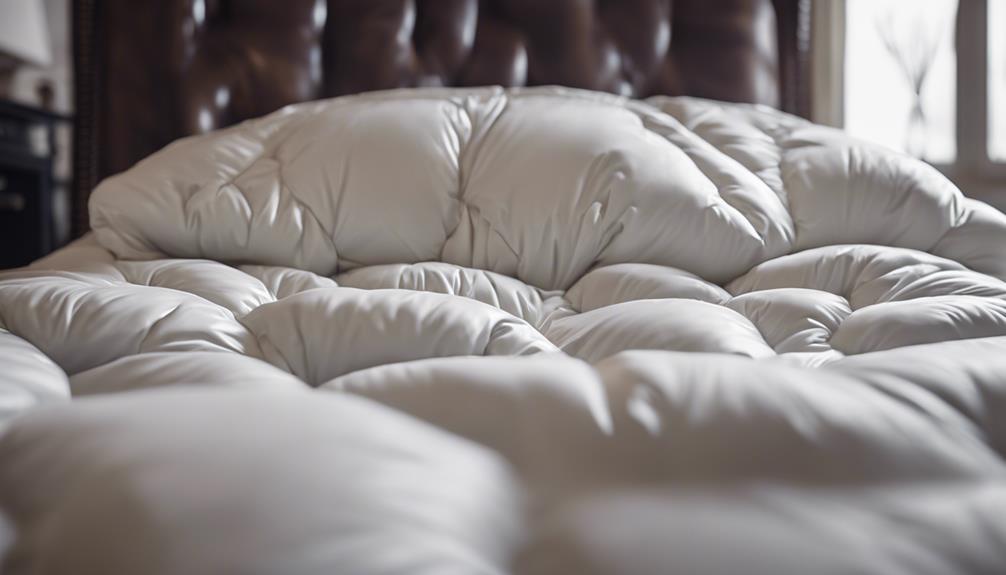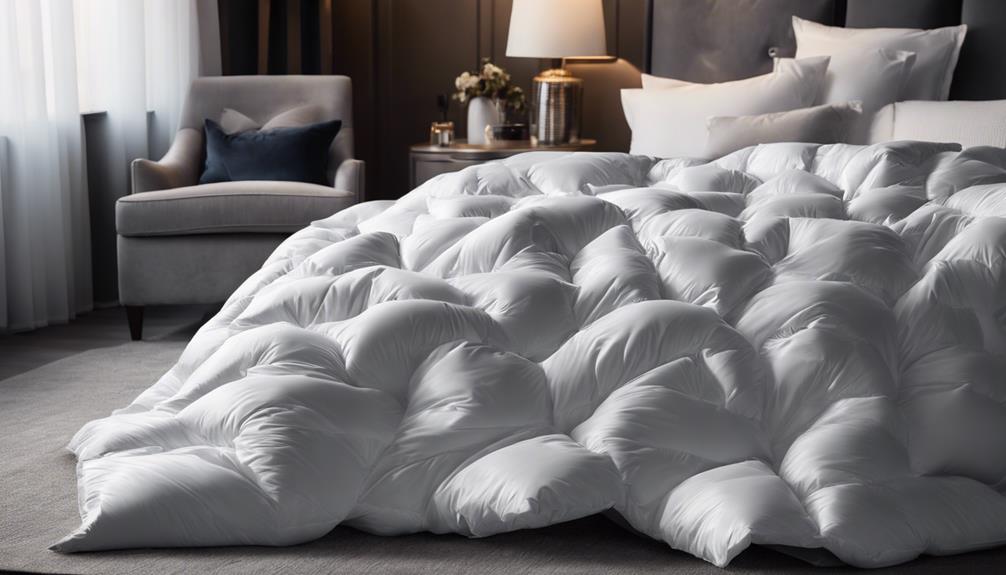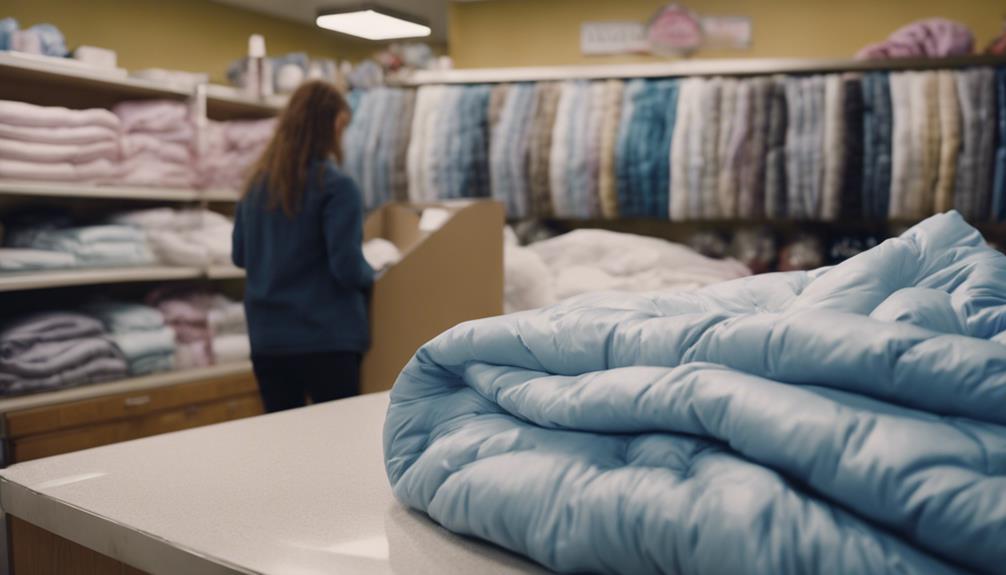Dry cleaning a down comforter usually ranges from $30 to $50. This thorough process effectively eliminates dirt, stains, and odors while maintaining the fluffiness of the comforter. Professional cleaners are experienced in handling delicate down filling with utmost care. There may be additional charges for specific treatments such as stain removal or fabric softening. The cost of dry cleaning a comforter is influenced by factors like the size of the comforter, type of fabric, and the location of the cleaner. If you are interested in understanding how comforter size affects pricing, the impact of location on dry cleaning rates, and ways to minimize dry cleaning expenses, continue exploring relevant information.
Key Takeaways
- Average cost: $30 to $50 for thorough cleaning.
- Factors: Size, fabric, location influence pricing.
- Additional costs: Repairs, stain removal, treatments.
- Impact of size: Larger comforters incur higher costs.
- Location effect: Urban areas charge $40 to $50, rural areas $30 to $40.
Average Cost to Dry Clean Down Comforter
When we dry clean a down comforter, the average cost typically falls within the range of $30 to $50. Dry cleaning a comforter is a common practice to maintain its quality and cleanliness. The cost includes cleaning the comforter thoroughly to remove dirt, stains, and odors. Professional dry cleaners have the expertise and equipment to guarantee the comforter is cleaned effectively without damaging the delicate down filling.
Opting for dry cleaning a comforter rather than washing it at home can prolong its lifespan and preserve its fluffiness. The cost of dry cleaning may vary depending on the size of the comforter, any special treatments required, and the location of the dry cleaning service. It's crucial to weigh the benefits of professional dry cleaning, such as expertise in handling delicate materials and ensuring a thorough cleaning process.
While the average cost may range from $30 to $50, additional charges could apply for services like mending holes or applying special treatments to the comforter.
Factors Influencing Dry Cleaning Costs
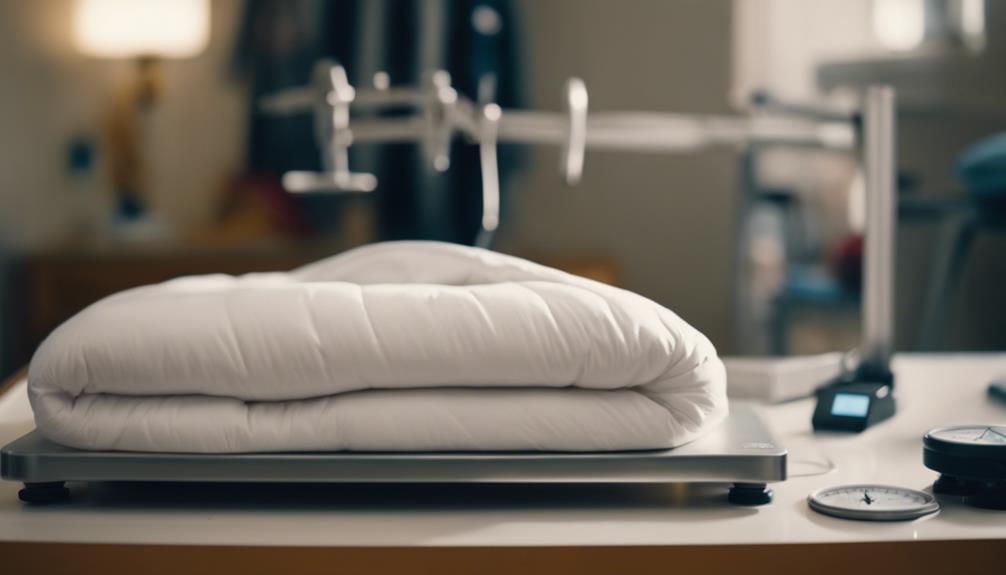
Factors impacting the cost of dry cleaning a down comforter range from $20 to $50 due to various considerations such as comforter size, fabric type, cleaner location, and equipment utilized.
The size of the comforter plays a significant role in determining the cost, with larger comforters generally costing more to clean. Delicate fabrics, such as silk or wool, may also lead to higher prices due to the special care required during the cleaning process.
Additionally, the location of the dry cleaner can influence costs, as prices may vary depending on the area's cost of living. Modern cleaning equipment, which guarantees a thorough and efficient cleaning process, may result in slightly higher charges.
It's worth mentioning that if the comforter is machine washable, opting to wash it at home can be a cost-effective alternative to dry cleaning. These factors should be considered when determining the most suitable and economical method for cleaning your down comforter.
Additional Services and Their Costs
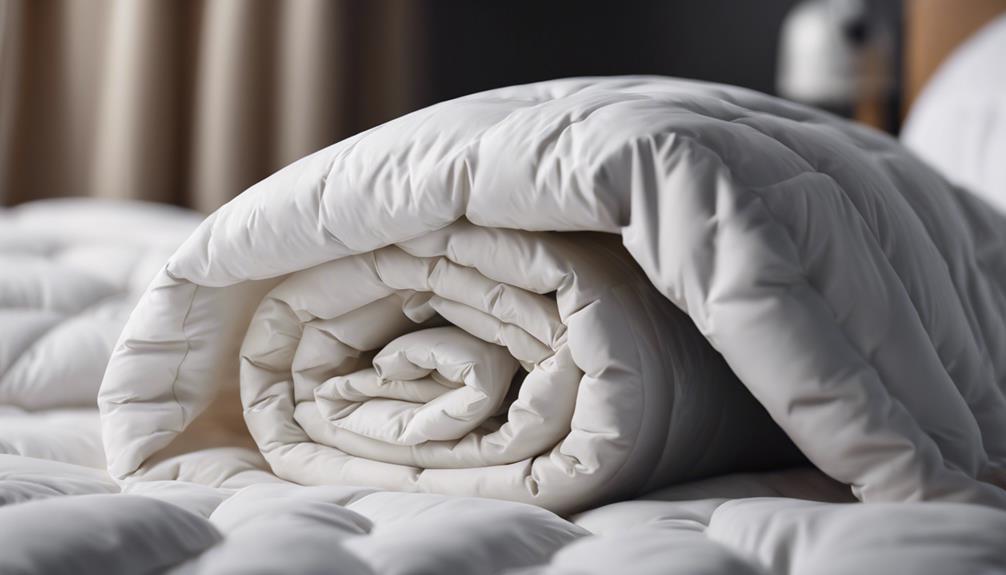
Considering the range of additional services available and their corresponding costs, it's essential to understand how these options can impact the overall expense of dry cleaning a down comforter. When opting for extra services during the dry cleaning process, there are various factors to take into account.
Mending holes or repairs may result in additional charges ranging from $5 to $15. Services like stain removal or odor treatment can add $10 to $20 to the total cost. If specialized treatments such as fabric softening or color restoration are desired, expect an increase of $10 to $30.
Quilting services for patching or stitching could cost $15 to $25, depending on the complexity of the work required. Custom alterations, like resizing or adding new features, may range from $20 to $50, impacting the overall dry cleaning cost significantly.
Before selecting any extra services, it's wise to weigh the benefits against the additional expenses to secure a satisfactory outcome for your down comforter.
Impact of Comforter Size on Pricing
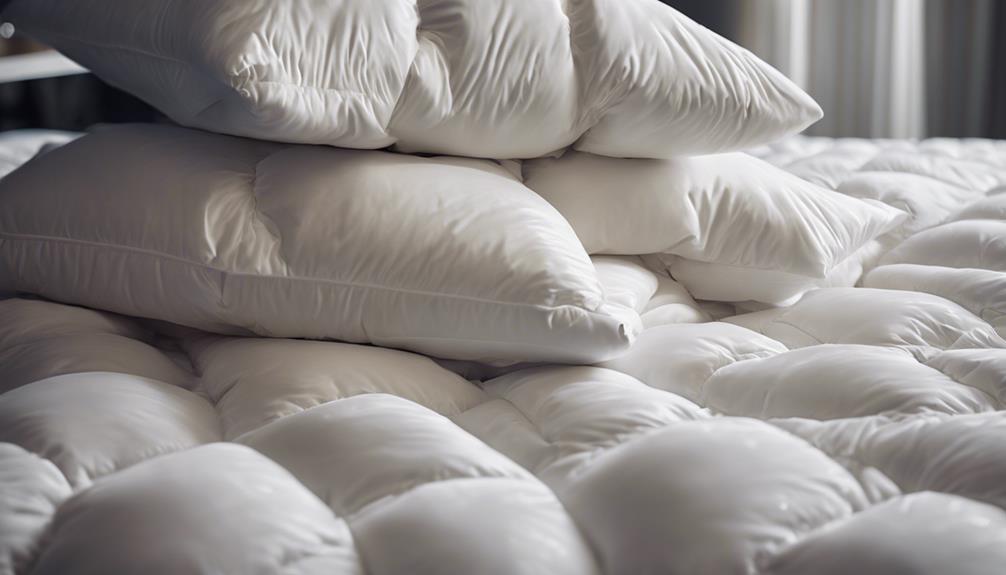
To understand how the price of dry cleaning a down comforter varies based on size, it's important to recognize that larger comforters, such as king size ones, generally incur higher costs. When dealing with big bedding like a king size comforter, the dry cleaning expenses can range from $30 to $50. This range is significantly higher than what you'd pay for smaller sizes like queen or crib comforters.
The size of the comforter directly impacts the pricing for dry cleaning services, so it's essential to be aware of this when estimating costs. If you own a king size comforter, be prepared to budget more for its cleaning compared to smaller alternatives. Understanding the implications of having a big comforter can help you plan your dry cleaning expenses more effectively.
Location's Effect on Dry Cleaning Rates

Dry cleaning rates for a down comforter can vary greatly depending on the location. Factors such as regional price variations, urban versus rural settings, and the economic impact on businesses can all play a role in determining the cost.
It's crucial to take into account where you're located when budgeting for the dry cleaning of your down comforter.
Regional Price Variations
Regional factors greatly influence the cost of dry cleaning a down comforter, with prices varying based on location. In urban areas or regions with a higher cost of living, the prices for dry cleaning a down comforter may be on the higher end of the spectrum, ranging from $40 to $50. On the other hand, in rural areas or locations with a lower cost of living, the prices could be more affordable, generally falling within the $30 to $40 range. Factors such as the availability of modern machines and specialized equipment at the dry cleaning facilities can also impact the final price. Below is a table showing the estimated cost range for dry cleaning a down comforter in different regions:
| Region | Price Range ($) |
|---|---|
| Urban High Cost | $40 – $50 |
| Rural Low Cost | $30 – $40 |
Urban Vs Rural
Comparing dry cleaning rates for down comforters between urban and rural locations reveals significant cost variations based on the area's economic factors and operational expenses. Urban dry cleaners tend to charge more for cleaning down comforters due to higher living standards and increased overhead costs.
In contrast, rural areas offer lower dry cleaning rates for down comforters, making them a more affordable option. The disparity in pricing between urban and rural locations is influenced by the operating expenses specific to each area. While urban establishments may provide certain conveniences, they often come at a higher price point.
On the other hand, rural dry cleaners, with their lower overhead costs, can offer competitive rates for cleaning down comforters.
Economic Impact
In different locations, the cost of getting a down comforter dry cleaned can vary considerably based on the economic influences at play. Areas with a higher cost of living often have higher dry cleaning rates, impacting the overall expense of cleaning a down comforter.
Different cities and neighborhoods may also have varying prices for dry cleaning services, further emphasizing the economic impact of location on these costs. Whether in urban or suburban areas, the rates for dry cleaning can differ significantly, showing how location plays a noteworthy role in determining the total cost of cleaning a down comforter.
Understanding these economic factors can help individuals plan and budget accordingly when it comes to keeping their bedding clean and fresh.
Comparing DIY Vs. Professional Dry Cleaning
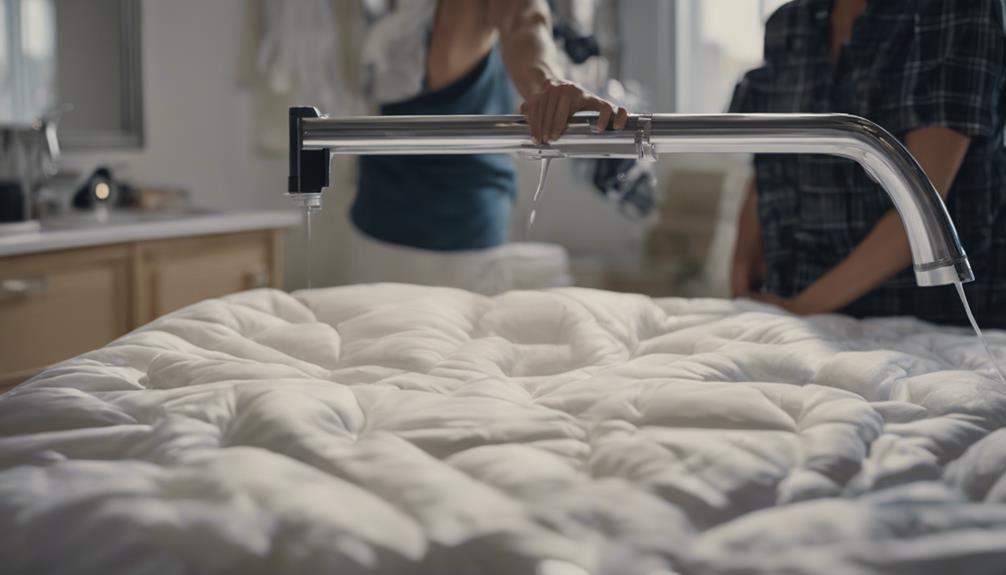
When evaluating DIY and professional dry cleaning for down comforters, it's important to take into account factors like cost, quality, and convenience.
DIY methods can be a more cost-effective option, while professional cleaning may use specialized solvents to maintain the comforter's quality.
Understanding the breakdown of costs and the impact on the comforter's longevity can help make an informed decision between the two cleaning options.
DIY Vs. Pro Comparison
Opting for professional dry cleaning for your down comforter guarantees expert handling and care, while tackling the task at home can be a more cost-effective alternative. Professional dry cleaning ensures proper handling of delicate down comforters, reducing the risk of damage.
On the other hand, DIY cleaning allows for more control over the cleaning process and choice of cleaning products. While professional dry cleaning may cost between $30 to $50, DIY cleaning at home can be a budget-friendly option.
Factors such as convenience, time, and the condition of the comforter play a role in deciding between the two methods. Ultimately, the decision between DIY and professional dry cleaning depends on individual preferences and priorities.
Cost Analysis Breakdown
Examining the potential cost savings and factors influencing pricing, it's important to conduct a detailed cost analysis breakdown when comparing DIY and professional dry cleaning options for down comforters. DIY cleaning at home using a washing machine and mild detergent can be cost-effective. Professional dry cleaning usually ranges from $30 to $50, considering the comforter's size.
Factors such as the materials used, additional services needed, and location can influence the overall cost. Adhering to care label instructions and proper cleaning methods helps maintain quality. Seeking discounts, membership services, and exploring washing alternatives are ways to reduce dry cleaning expenses for down comforters.
It's vital to weigh these factors when deciding between DIY and professional dry cleaning options.
Quality and Convenience
Professional dry cleaning services provide a level of quality and convenience that DIY washing at home may not match for down comforters. The washing capabilities of professional dry cleaners guarantee a thorough and safe cleaning process, using specialized solvents and techniques tailored to delicate down comforters. Proper care is assured, minimizing the risk of damage that DIY washing may pose.
While DIY washing can be more cost-effective, it may not offer the same level of cleanliness and preservation of the comforter's quality. Professional dry cleaning, though it may come at a higher cost ranging from $30 to $50 depending on the size, materials, and additional services needed, offers peace of mind and assurance of a proper cleaning process for your down comforter.
Tips to Reduce Dry Cleaning Expenses
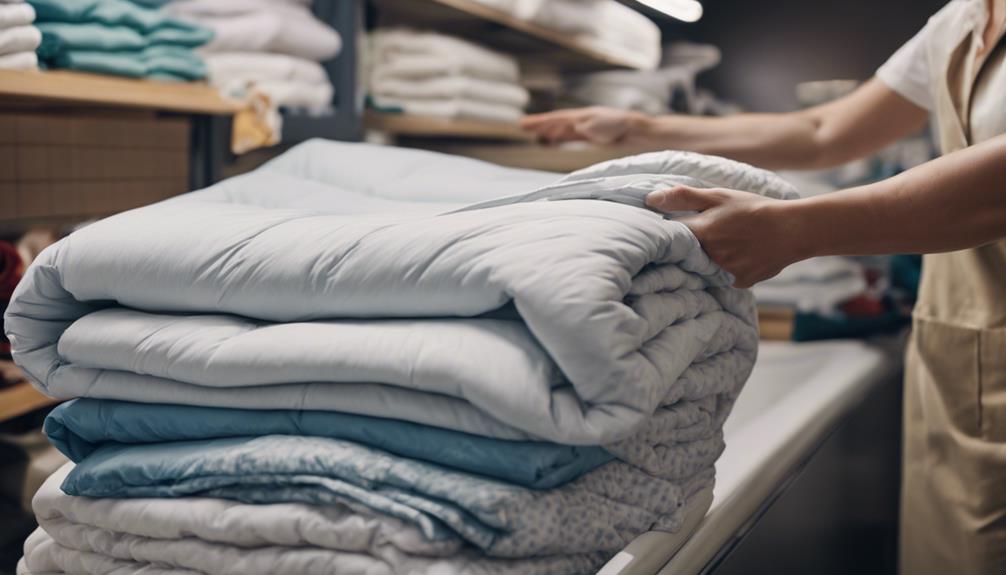
To guarantee the longevity of your down comforter, it's crucial to consider machine washing at home as a practical and cost-effective solution for reducing dry cleaning expenses. By adhering to the care label instructions and using a gentle cycle with mild laundry detergent, you can minimize the risk of damage and the necessity for professional cleaning.
Seeking discounts as a regular customer or through membership services can also help decrease overall dry cleaning costs. Choosing bedding that doesn't require dry cleaning can entirely eliminate those expenses. Moreover, using specialized DIY cleaning kits designed for down comforters can be a wallet-friendly option to maintain cleanliness without the reliance on dry cleaning services.
These strategies can help you save money while still ensuring your down comforter remains fresh and cozy. It's important to strike a balance between cost-saving measures and proper care to preserve the excellent condition of your comforter for years to come.
Environmentally-Friendly Alternatives to Dry Cleaning

Exploring eco-friendly options for cleaning your down comforter can help reduce environmental impact while maintaining its freshness and quality. When looking for alternatives to dry cleaning, washing your comforter at home with a mild detergent is a sustainable choice.
Utilizing a front-loading washer at a laundromat is another environmentally-friendly option for cleaning down comforters. Additionally, hanging the comforter outside on a sunny day can help freshen it up without the use of harsh chemicals.
If you prefer using a commercial laundromat, opting for one with large washers is an eco-conscious way to clean your down comforter. For a simple yet effective method, you can wash the comforter with regular detergent and a clean canvas sneaker in the dryer.
Cost Comparison With Washing at Home
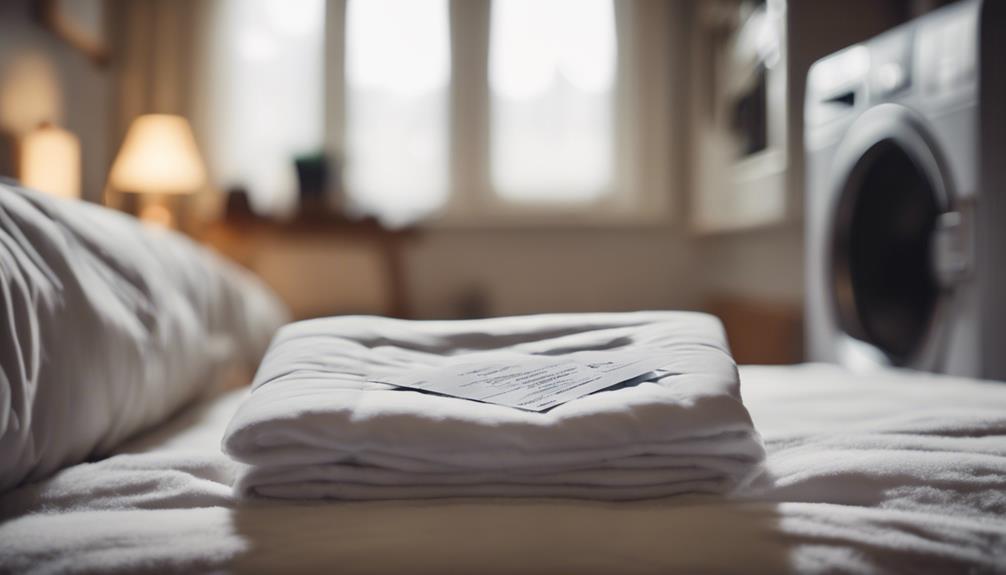
Comparing the cost of dry cleaning a down comforter with washing it at home reveals a significant difference in expense. When contemplating the option of washing a queen size down comforter at home, the cost-effectiveness becomes apparent. Here are some key points to ponder:
- Cost Efficiency: Washing a down comforter at home can be much more economical than dry cleaning, especially for larger sizes like queen.
- Convenience: While home washing methods may require access to a large machine or a trip to the laundromat, the overall convenience and savings can outweigh this inconvenience.
- Maintenance Benefits: Washing at home allows for the use of gentle cleaning methods, helping to maintain the comforter's loft and quality over time. This can prolong the lifespan of the comforter, making it a cost-effective choice in the long run.
Taking these factors into account, opting to wash a queen size down comforter at home can be a practical and budget-friendly alternative to dry cleaning.
Frequently Asked Questions
How Much Does It Cost to Dry Clean a Feather Down Comforter?
Dry cleaning a feather down comforter typically costs between $30 to $50, influenced by factors like size and location. Additional fees may apply for special treatments or repairs.
Larger comforters, like king size, generally incur higher costs than smaller sizes. The overall price can vary based on the equipment and materials used by different dry cleaning establishments.
Is It Better to Wash a Down Comforter or Dry Clean It?
When deciding whether to wash or dry clean a down comforter, consider that washing at home can be cost-effective but may not prevent shrinkage. Dry cleaning, costing $30 to $50, can protect against shrinkage but might damage the down. Check the care label for guidance.
Some cleaners offer laundering as an alternative. Proper care guarantees your comforter stays cozy and clean.
Are Comforters Worth Dry Cleaning?
Dry cleaning a down comforter can be essential for maintaining its quality and longevity. The process can range from $30 to $50, depending on size and location.
It's important to check the care label to determine if dry cleaning is necessary. Some dry cleaners offer laundering services, which can be gentler on the comforter.
Using a duvet cover can also help reduce the need for frequent cleanings, potentially saving on costs in the long run.
Can You Put a Goose Down Comforter in the Washing Machine?
Putting a goose down comforter in the washing machine is possible for some, but always check the care label first. We recommend front-loading machines for this task.
Thoroughly drying the comforter is important to prevent odors and moisture. Fluff it with tennis balls or a clean sneaker in the dryer to maintain its fluffiness.
Proper care guarantees longevity and cleanliness for your down comforter.
Conclusion
To sum up, it's worth noting that dry cleaning a down comforter can cost between $20 to $40, depending on various factors such as size, location, and additional services.
Studies have shown that opting for professional dry cleaning can increase the lifespan of your comforter by up to 5 years, which can ultimately save you money in the long run.
Keep these factors in mind when deciding whether to dry clean or wash your comforter at home.
